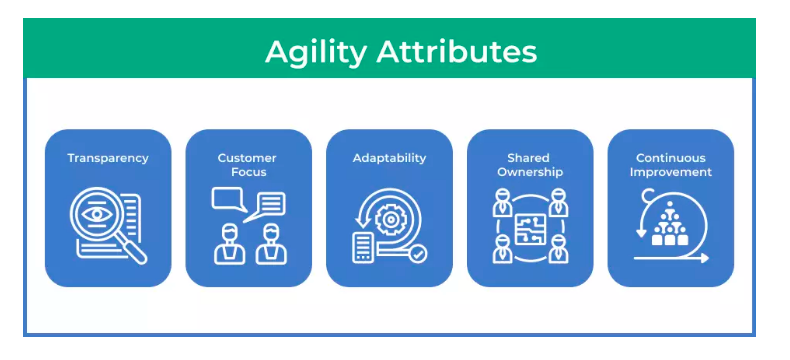What Are the Differences Between Agile and Traditional Project Management, and Which Is Better?
In today’s fast-paced world, project management platforms have become an essential skill and a must. From minor to medium to large, every business size relies on project management to successfully deliver its products and services.
Quick Links
There are many project management approaches available today worldwide, and a lot of businesses have advantages from them. Agile and traditional project management are two of the most widely used methodologies.
Making a difference between these two project management,71% of businesses agreed that Agile practices should be used frequently, occasionally, and permanently.
What Is Agile?
Agile is a software development methodology and project management that allows teams to provide client value faster and with fewer problems.
Scrum, Feature Driven Development (FDD), eXtreme Programming (XP), Dynamic Systems Development Method (DSDM), Adaptive Software Development (ASD), Crystal, and Lean Software Development are some of the most popular and widely used examples (LSD).

Here’s an illustration of how Scrum works: Bill meets with a client to discuss his company’s requirements. These requirements comprise the product backlog. Bill selects the most important tasks to complete over the next two weeks.
His team meets in a daily scrum to plan out the day’s work and address roadblocks. At the end of the sprint, Bill completes the work, reviews the backlog, and establishes the goal for the following sprint. The cycle is repeated until the software is finished.
Agile Project Management Methods
Kanban

Kanban is a method that was developed over a decade ago. It emphasizes evolutionary change and continuous process improvement.
Scrum

Many people mistake Scrum for an Agile method, but it is a prescriptive framework. It is an iterative approach that divides projects into fixed periods called sprints and uses time-boxed intervals. The primary goal is to assist teams in producing high-value products productively and creatively.
Scrumban

As Kanban gained popularity, some members of the Agile community saw an opportunity to create a method that allows Scrum teams to move forward while focusing on continuous improvement and evolutionary change. Scrumban was born as a result of this.
What Is Traditional Project Management?
Project management is a time-honored tradition. Project management can be found in the construction of the Pyramids or the Taj Mahal and in more current projects such as the development of highways, roads, bridges, new cities, new railroads, and new products, to name a few.
Project management is a discipline that consists of a set of tried and true practices, tools, and techniques for project management.
The Gantt chart is the most essential tool in traditional project management. Henry Gantt invented it, which is why he is known as the “Father of Traditional Project Management.”

The project activities are shown on the left side of the Gantt chart, and the time scale is shown on the right. A bar is displayed for each activity. The position of a bar indicates the start, duration, and end of an activity.
Why Is Agile Important?
Agile project management employs brief development cycles known as “sprints,” each of which incorporates and adapts to customer feedback to produce a finely tuned end product.
Agile methodologies are also beneficial to SEO. Between evolving search algorithms, fierce rivalry, and the never-ending flow of fresh content by using SEO keyword research services, SEO is based on a continually moving set of parameters. For social media, you can also employ an agile approach to ensure that your team takes into account growing trends, trending hashtags, and other opportunities to grow fast.
The following are the most common reasons given by firms that switched from traditional to Agile project management:
- By using different project management software and Agile,collaboration between teams has improved by 54%.
- Improves software quality in enterprises by 52 %.
- Customer satisfaction has increased by 49% as a result of the changes.
- Reduces time to market by 43%
- Cost of development is reduced by 42%.
Here’s an example of effective agile management, within two months of launching the mobile application, Instagram had a million downloads.
When it came to conceptualizing a new product, Instagram’s team relied on the Waterfall model’s efficiency. After testing the mobile app with real users, we received comments from them. The team used the Agile method to make quick changes, such as removing unneeded items.
The team was able to give what customers genuinely desire rather than what they anticipated they would want as a result of this. After implementing Agile in the construction process and re-testing the product. Then came the launch of the mobile app, and the rest is history.
Improved Product Quality
Because testing is built into the project development process, the team can conduct regular checkups and identify areas for improvement.
Risk Reduction
The danger of a comprehensive project failure is essentially eliminated with Agile project management.
Greater Transparency Into Project Performance

Agile project management keeps team members up to date on the project’s progress. Scrum meetings and sprint reviews are held on a regular basis, which increases transparency for the entire team.
Enhanced Project Control
Team members have more opportunities to test and adapt as the project progresses.
Improved Project Predictability
By dividing the project into shorter sprints, project managers can accurately predict the cost, timeline, and resource allocation required for each sprint.
Why Is Traditional Project Management Important?
Traditional project management can be used successfully for most projects in most industries where requirements are defined ahead of time. Traditional project management may be ineffective where requirements change frequently, and the anticipated change is significant.
Traditional Project Management vs. Agile Project Management: The Differences
Find below some difference between these two methods:
2. Transparency

In Agile project management, every decision and plan is available to the public. Making decisions and modifications involves everyone, including the product owner, team members, and clients.
In a typical project management method, the manager takes all critical decisions or works with only a few senior personnel.
3. Scope for Feedback
When designing or building a new product using the traditional process, you must plan everything from the start. You must perform each work within the time and money constraints that have been established. That implies you can’t make any significant adjustments based on customer feedback that might cause the product’s delivery to be delayed.
On the other hand, the Agile strategy allows you to take frequent feedback from the product owner and customers. Continuous feedback can assist you in achieving more excellent results and meeting deadlines while delivering high-quality items. As a result, project managers prefer Agile to traditional project management.
4. Project Complexity
All difficult jobs are well-suited to Agile project management. If your project’s stages are interrelated or are dependent on one another, the Agile approach is the ideal way to make work clear and reduce complexity. Frequent inspections and adaptations aid in the reduction of complexity and ambiguity in requirements.
While traditional project management methodologies use a linear approach, they can manage complicated projects with ambiguous requirements and complex activities. As previously said, you can’t make drastic adjustments to this strategy. Traditional is a better choice for undertakings that aren’t as complicated or as little.
5. Customer Satisfaction

In the Agile framework, customers play a critical role. It places a greater emphasis on exceeding client expectations by embracing input after each iteration. As a result, individuals can contribute valuable ideas and motivate the Agile team to act on feedback correctly.
Because Agile project management prioritizes client feedback, the team can comprehend the customer’s needs and deliver high-quality products and services. It aids in the retention of customers and the improvement of satisfaction.
6. Accountability and Ownership
Another reason why businesses prefer Agile project management to the traditional approach is accountability and ownership. Each team member has ownership and accountability for the project in agile. Everyone in the Agile team contributes equally to completing a project within the deadline.
On the other hand, in traditional project management, the project manager is the sole proprietor of the project.
Traditional Project Management vs. Agile Project Management Features
The table below summarizes the key features between Agile and traditional project management:

Conclusion

Larger organizations and initiatives may prefer to employ the traditional technique if they want a tried and true framework that provides the required results on time and within budget. An Agile approach may be the best option if the requirements aren’t precise or the organization is small and collaborative.
When studying a goal, analyze the risk level in the same way. If there are many risks, or if the requirements are constantly changing, go with an Agile framework.
Within the shorter sprints, you may swiftly address and resolve difficulties. If there are significant projects with little tolerance for error, the traditional method’s meticulous planning and documenting ensures that scope changes are kept to a minimum.
How to Use AI-Powered SEO Tools for WordPress eCommerce
SEO is a critical factor in the success of any e-commerce WordPress store. As competition…
0 Comments11 Minutes
Why Short-Form Videos Are the Future of Content Marketing
Your Instagram customers spend over 50% of their time watching short-form videos and reels. Rather…
0 Comments12 Minutes
The Role of Digital Marketing in Business Growth
Online marketing touches every aspect of a business, whether it is initiating the idea or for an…
0 Comments3 Minutes
AI Meets Authenticity: Balancing Automation and Human Touch in Content Marketing
Is your brand starting to sound like a robot? In a world where algorithms write faster than any…
0 Comments8 Minutes
Essential Tools for Enhancing Web Design and UX Hosting
Have you ever visited a website that felt slow, clunky, or confusing? A website that is poorly…
0 Comments11 Minutes
How a Mini Cart Transformed My Store’s Shopping Experience
Okay, real talk—running an online store is hard. You think you’ve got everything figured out, you…
0 Comments9 Minutes
Balancing Your Security Initiatives With Industry Compliance Requirements
Managing a business today comes with a number of daily battles that need to be fought. Resources…
0 Comments11 Minutes
Best plugins to enhance the customer shopping experience
Customer experience is a key part of every online store. A good experience helps customers find…
0 Comments7 Minutes








